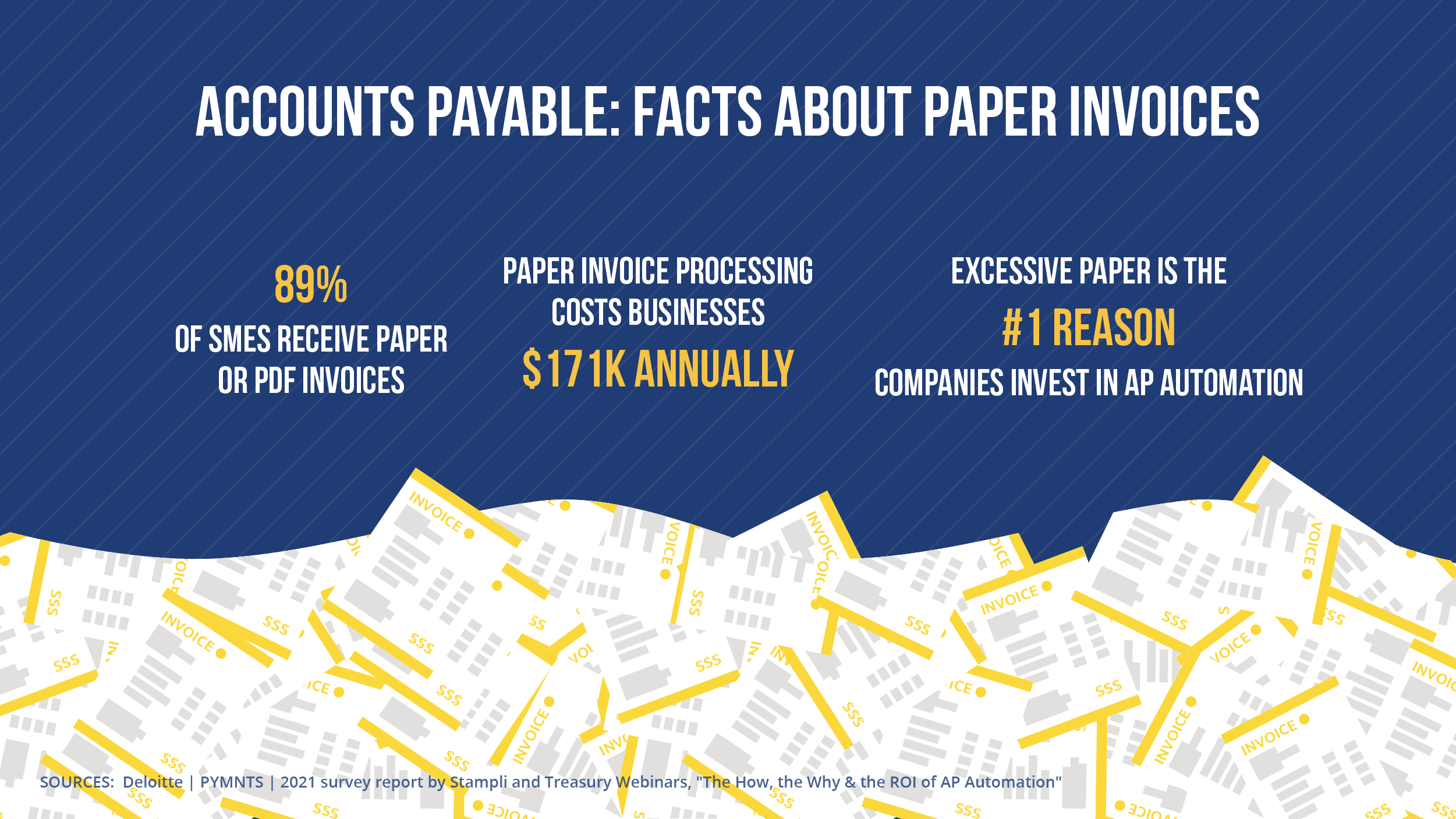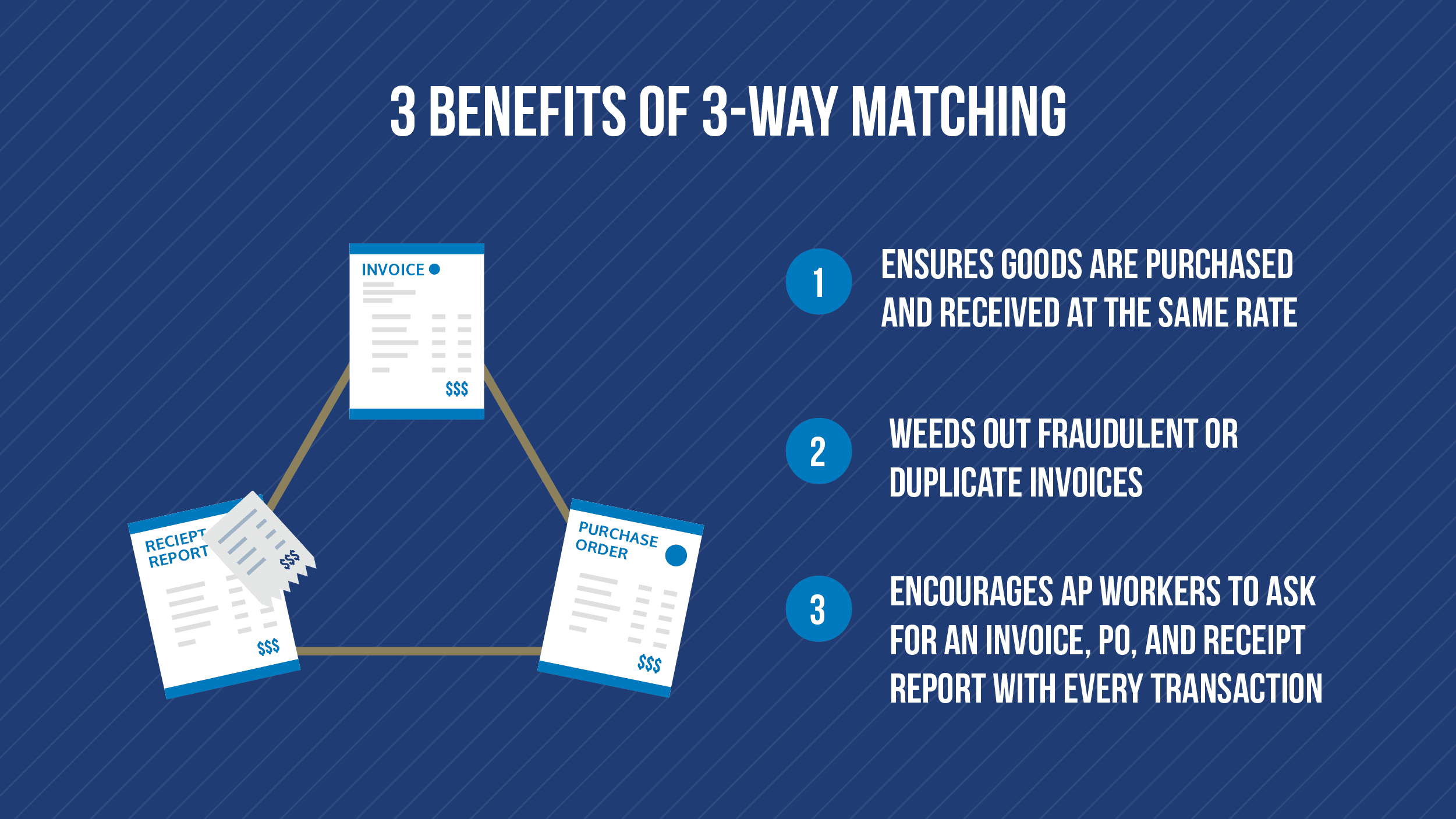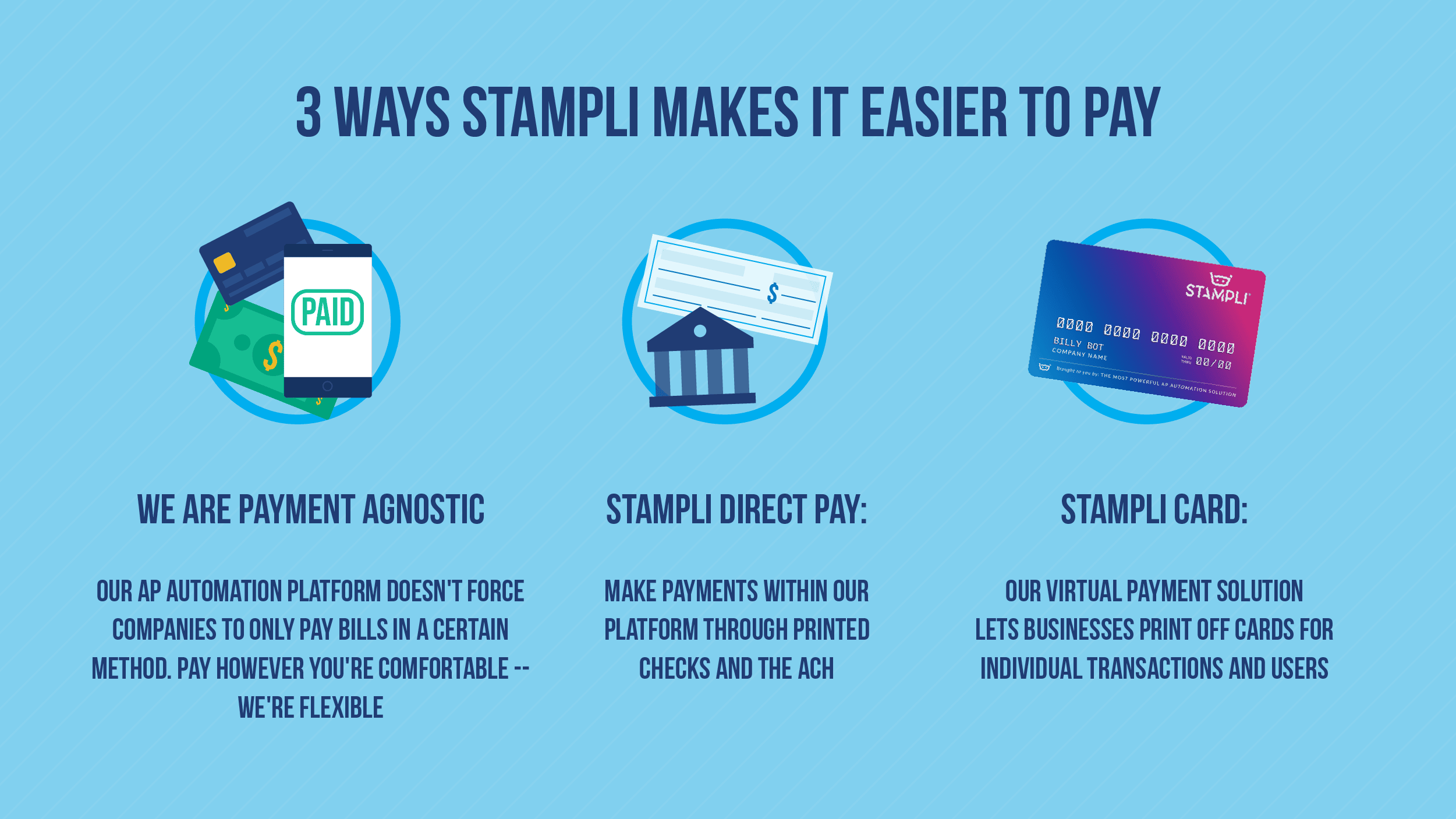The Real Challenge of Accounts Payable May Surprise You

To work in accounts payable is to regularly deal with challenges.
From long amounts of time needed for manual invoice processing to lost discounts and late fees incurred, AP can be a quagmire. Left unchecked, each of the different challenges can lead to inefficient operations, higher invoice processing costs, and strained vendor relationships.
But there’s a simple solution, one that can lead to brighter days for AP teams and their leaders.
Today, we’re going to look at 10 of the most common challenges that befall the world of accounts payable. We’ll also explore how AP automation platforms such as Stampli can help to resolve each challenge.
1. Too Many Paper Invoices
A 2021 survey report by Stampli and Treasury Webinars, “The How, the Why & the ROI of AP Automation” looked at some of the top reasons why companies invested in AP automation. The No. 1 reason for automation investment, at 35% of respondents, was excessive amounts of paper.

Even with stark revelations, such as the fact that processing invoices in paper form costs businesses an average of $171,000 each year, paper invoices remain a common part of B2B life. A 2021 study by Deloitte found 89% of small and medium-sized businesses still processed either paper or PDF invoices. And to try to strong-arm vendors and suppliers into only sending digital invoices is foolhardy. Letting people do what they’re comfortable with is a business necessity.
That being said, here are the reasons ways getting an AP automation platform in place can foster paperless vendor and supplier relationships.
How AP automation helps: Platforms like Stampli come with vendor portals where goods and service providers can submit their invoices digitally. Part of the incentive for vendors and suppliers to do this is that the portals can offer real-time updates on invoice status.
Vendors seem to be getting onboard with the idea of accounts payable automation and sending fewer paper invoices. The Stampli and Treasury Webinar’s ROI report linked above noted that 44% of respondents saw a reduction in paper invoice volume with AP automation.
2. Data Entry
It’s not just AP workers who despise manual data entry, with a survey of office workers naming it the most-hated task. Payable departments may need to post a large number of invoices, with a 2021 survey report by Stampli and Treasury Webinars, “AP Today: Bottlenecks, Benchmarks & Best Practices” noting 54% of companies processed more than 500 invoices each month.
Unfortunately, low enthusiasm for having to manually punch an invoice into an accounting system can lead to data entry errors, which can affect the financial statements.
How AP automation helps: The platforms use tools like optical character recognition (OCR) software and, increasingly, artificial intelligence and machine learning to digitize and streamline the processing of paper invoices.
OCR isn’t foolproof, with 1% to 2% considered an acceptable error rate. Among other things, OCR can get thrown by incoming invoices in different formats than normal. Thus, for companies that lack AI in their accounting software and are strictly reliant on OCR for invoice scanning, manual follow-up with each invoice is a wise course of action.
3, Lots of Time Spent on Invoice Processing
If only accounts payable work were as simple as getting a bill, paying it, and moving on. Stampli and Treasury Webinars’ survey report on AP bottlenecks noted these average times for getting an invoice paid:
- 15 days for companies with fewer than 100 employees;
- 17 days for companies with 100-1,000 employees;
- 20 days for companies with more than 1,000 employees.
Clearly, it can take a lot of time to resolve even a single invoice. Some companies might simply tolerate slow processing, thinking it just part of their world. Other firms have overly-complex approval chains. And then there are those businesses which lack a clearly-delineated process for resolving invoice exceptions, however frequent they might be.
How AP automation helps: A recent study by PYMNTS.com found a staggering 98% of businesses believed that AP automation speeded up payments. In addition, in the Stampli and Treasury Webinars’ report on ROI, 57% of respondents attested that implementing AP automation led to quicker approval of invoices.
AP automation software helps reduce time spent on invoice processing in a variety of ways. This can include automated workflows and approvals, as well as instant resolution of invoice exceptions via AI and machine learning. There also might be a morale boost. As AP workers notice that invoice approval isn’t taking as long, they might feel energized. They can put this energy toward more high-level tasks, which are better uses of their time.
4. Three-Way Matching Difficulties
Three-way matching of purchase orders, invoices, and receipt reports helps to ensure that companies get the goods they pay for at the amount they agreed to pay, including changes in-transit.
Clearly, three-way matching is smart AP practice. But it can also be a hassle to attempt three-way matching manually, with forms sometimes going missing. Accordingly, many companies don’t even bother, with Stampli and Treasury Webinars’ report on AP bottlenecks linked above finding that only 51% of respondents were at companies using three or four-way matching for PO approval.

While three-way matching might sometimes seem like more work than it’s worth, there are definitely ways to make it easier.
How AP automation helps: Forget about the days of having to hunt invoices, POs, and receipt reports by hand. AP automation platforms store these forms in the cloud, linking them to specific transactions.
5. Lost Early Payment Discounts and More Late Fees
Many vendors have long offered discounts typically ranging from 1% to 3% to companies willing to pay invoices early. And in a volatile economic climate marked by inflation, the size of these discounts seems to be increasing. PYMNTS.com noted in February 2022 that the average small business was giving a discount of 4.1% for early payment.
Still, the discounts get collected less frequently than one might think, with PYMNTS.com noting in May 2022, “While SMBs often offer discounts and incentives to encourage business partners to make one-time payments on time, that strategy doesn’t work. More than one-third of these ad hoc vendor payments for which discounts are available still arrive late, and another one-third are paid just on time — not earlier.”
It’s not just lost discounts, but fees and interest for late payments that can quickly compound, leading to cash flow issues.
How AP automation helps: By speeding up the AP process, automation helps businesses capture more early payment discounts and avoid penalties.
6. Vendors Calling and Emailing to Ask When They’ll Get Paid
It’d be one thing if delays in paying vendors led only to lost discounts and incurred late fees. But there’s also an indirect cost associated with all of the time-consuming work for staff responding to vendors, suppliers, and contractors calling or emailing, anxious to know when their money will arrive.
Suffice it to say, a lot of staff time can be taken up sitting on the phone listening to a vendor rant, typing out a reply email, or recovering after either.
How AP automation helps: Aside from allowing vendors to submit invoices, vendor portals also help answer questions before vendors ever opt to pick up the phone or send an email.
7. Internal Communications
Communication problems don’t just arise with antsy vendors. Part of the challenge of the AP process is that it can be disjointed, with different teams handling different roles. This can lead to internal communication difficulties, with a lack of clarity between different team members in what’s occurring in the procurement-to-payment (P2P) process.
How AP automation helps: Platforms provide end-to-end visibility, letting authorized users know exactly where an invoice is in the queue. AP automation systems like Stampli also include a communication window with every invoice, letting users log relevant notes and insights associated with the transaction.
Communication is also aided by usable systems like Stampli. No one gets shut out of a conversation because they can’t figure out how to maneuver around the system (though for anyone confused, Stampli also offers dedicated user support.)
While we’re at it, another thing that AP automation platforms like Stampli are really good at communicating with are ERP systems. We’re among the most versatile of platforms, able to integrate with many of the top ERP providers, including Oracle, SAP, Microsoft, and Sage Intacct.
8. Difficulty Paying Vendors After Processing Invoices
Some AP automation platforms make it easy to do everything in the P2P process except, that is, for payment. An invoice can be processed straight through in the platform, with clean data. But then the company has to go into a different platform to make the payment and things can start to go sideways.
Sometimes, it’s about a particular AP platform not having a vendor’s preferred payment method, be it check, automated clearing house (ACH), or credit card, which made up about 90% of preferred methods in another 2021 survey by Stampli and Treasury Webinars, “How & Why Companies Choose Payment Types.”
That same report noted that companies are driven more times than any other, at 46% of respondents, to choose payment types based on processing costs. And again, not every accounting system is going to have every remittance method, regardless of the benefits.
How AP automation helps: The best AP automation platforms, such as Stampli, are payment agnostic, allowing companies to use whatever method people prefer, be it electronic payments, checks, or whatever. Our payment innovation, Stampli Direct Pay lets companies make payments within our platform via the ACH or printed checks.

Stampli Card can also integrate directly with our AP automation system, allowing companies to make easy payments and then have the data instantly available.
9. Fraud, Both Internal and External
Fraud plagues accounts payable and is on the rise, with B2B payment fraud up 10% during the COVID-19 pandemic.
The fraud happens in a variety of ways within AP. A 2022 survey by the Association for Finance Professionals finding that 58% of respondents noted their AP departments had attempted email scams in the preceding year. There are impersonation scams, log-in breaches, and the good old-fashioned Nigerian scam for businesses to monitor.
All the same, it’s not just clandestine external actors that companies have to guard against. AP employees can easily be corrupted or simply go rogue into embezzlement, misdirecting funds, or making unauthorized purchases. Internal AP fraud isn’t the easiest thing to detect, particularly for uncompromised payable team members or other parts of their companies that are still primarily doing manual processing.
How AP automation helps: AI bots in AP systems like Stampli can review untold numbers of transactions, looking for discrepancies or other signs of fraud. Red flags can include unusually high transactions and wildly different purchasing amounts for certain internal departments.
The AI and machine learning capabilities of AP automation can also flag double payments. While duplicate payments aren’t necessarily fraudulent, they can effectively have similar impacts on a company’s bottomline.
(Aside from AP automation, something else worth noting here: Another fraud protection we offer is through Stampli Card, our virtual payment solution. These cards can be created for individual transactions, with set amounts that specified users can spend.)
10. Reconciliations and Audit-Readiness
Maybe the worst day each month in an accounts payable department? Month-end, the time when AP departments can effectively shut down while they attempt to reconcile the accounting records in their enterprise resource planning (ERP) system with other financial data to make sure that the balances agree.
For companies that do most of their accounts payable work by hand (including by printing off PDF invoices from emails), these days can be rough. Imagine walking through an AP department and seeing staff with pages upon pages of transactions printed and sitting on their desks. Worse, these pages might not have detailed breakouts for line items, forcing workers to pore through invoices and attempt to reassemble manual records. Lost invoices can also hinder this process.
A rough month-end process can pave the way for poor audit preparedness. If a company can’t ensure that its balances are accurate from month to month, its struggles can multiply exponentially when a professional auditor arrives.
How AP automation helps: AI and machine learning can automatically perform reconciliations, as often as a company needs it. When it comes to audit readiness, financial records like invoices, purchase orders, and receipt reports and reconciled books are stored electronically within AP automation platforms in clear and audit-ready formats.
Don’t let accounts payable challenges get you down. See how Stampli’s No. 1-ranked AP automation platform can help.